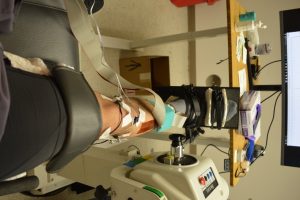
Many lower extremity exoskeletons assist in locomotion, but for this to be possible, the exoskeleton must work in synchrony with the user. Adaptive control for this interaction proves to be difficult because of how dynamic humans are. Many of the commercially available lower extremity exoskeletons attempt to provide adaptive control for their dynamic users in a reactive manner by using sensors to interpret the user’s action. This often results in a time-lag between user movement and augmentation. A possible solution to reactive control is proactive control; that is, being able to extract movement intent before the actual movement occurs. A possible method for extracting movement intent is by measuring surface electromyography (sEMG) with a high-density electrode grid. The decomposed sEMG signal can then be used to reconstruct movement intent, and could possibly be used to improve myoelectric control. This project is in collaboration with Draper Laboratories [Cambridge, MA] and Army Research Laboratories [Aberdeen, MD].
Logan P. Leahy
